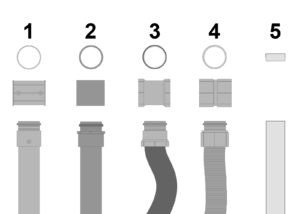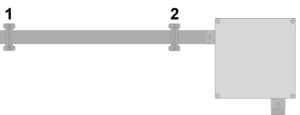Conduit
As wires run from one connection point to another, they should be placed in some type of conduit to protect them from physical damage that can result from abrasion, contraction and expansion, the sun, rodents, or chemicals. The term conduit refers to a variety of different types of plastic or metal forms of protection that can be used. The appropriate type of conduit will vary based upon:
- Where the wire/conduit will be located: What will offer the best protection given the conditions. For example, if conduit will be located outside, it is necessary to choose a conduit that is appropriate for use in wet conditions.
- Building construction: Will the conduit/wiring be run inside a wall? If it is to be run inside a wall, an appropriate conduit should be chosen. On the surface of a wall? Various conduit types may offer sufficient protection, but some may be more aesthetically pleasing than others.
- The local electrical code/local practices: It is the best practice to follow the electrical code in any given location, but local practices may dictate a different approach.
- Local availability of materials: Some components and materials are not available in all locations.
Contents
Conduit types
There are several broad categories that most types of conduit fit into. The actual appearance of the conduit, connectors, and couplers may vary from place to place. Connectors are used to connect the conduit to a junction box. Couplers are used to connect sections of conduit together as they typically come in 3 m or 10' sections.
Metallic conduit
Metallic conduit offers excellent protection under appropriate conditions but may not be the cheapest, simplest, most widely available option. That being said, metallic conduit will result in a high-quality installation if used appropriately. It can be bent into angles with appropriate bending tools or sections can be bought that are pre-bent to specific angles (15°, 30°, 45°, 90°). There are a few different types of metallic conduit available which are classified based upon the thickness of the walls of the tubing:
- Electric metallic tube (EMT): The thinnest options which is intended for use indoors - on walls or inside walls.
- Intermediate metal conduit (IMC): A thicker-walled option that offers more durable protection. Can be installed outdoors with appropriate connectors,couplers, y junction boxes.
- Rigid metal conduit (RMC): The thickest-walled option that is the most durable. Can be installed outdoors or buried with appropriate connectors,couplers, junction boxes.
PVC plastic conduit
PVC conduit offers excellent protection under nearly all conditions, is cheap, simple, and common. PVC conduit is frequently used inside walls and on the surface of walls in many parts of the world. PVC conduit can used in wet locations or buried underground as it does not corrode and can be made watertight by using appropriate fittings and sealants. It is possible to bend PVC by heating the conduit, but this requires various specific tools, therefore pre-bent sections are typically used to make bends (15°, 30°, 45°, 90°).
Flexible metal conduit
Flexible metal conduit (FMC) is simple to work with and commonly available. It has the advantage of being flexible, meaning that it is often possible to avoid many of the challenges that come with putting bends into other types of conduit. Traditional FMC is rated only for indoor use, but there is a rubberized version called Liquidtight FMC that (LFMC) that can be used outdoors, in wet locations, or buried in short sections if necessary.
Flexible non-metallic conduit
Flexible non-metallic conduit (FNC) is simple to work with and commonly available. It is only rated for indoor use and does not offer as durable of protection as the other options but is typically fine in most locations.
Cable tray
Cable tray is a term that refers to many different types of products, but the most commonly used is made out of a rectangular PVC channel with a removable lid. It may come with an adhesive backing as well. This type of cable tray is commonly used in many locations to install lighting and outlet circuits on the surface of walls as it minimized installation time and can keep costs low, but cable trays do not offer the best protection and do not last as long as the other options.
Conduit size
It is necessary to choose a size of conduit that is appropriate for the number of wires that will be installed in the conduit. A conduit that is too small presents various problems as wires may not be able to pass through bends, they may be damaged as they are pulled through the conduit and they may be unable to properly cool themselves. Conduits typically come in standard sizes:
| Size (standard in inches) | Size (metric in mm) |
|---|---|
| 1/2" | 16 mm |
| 3/4" | 21 mm |
| 1" | 27 mm |
| 1-1/4" | 35 mm |
| 1-1/2" | 41 mm |
| 2" | 53 mm |
| 2-1/2" | 63 mm |
| 3" | 78 mm |
| 3-1/2" | 91 mm |
| 4" | 103 mm |
The number of a particular type of wire that can fit in a conduit depends on the internal diameter of a conduit, which will vary based upon the conduit type and the wall thickness of the particular conduit. The general guidelines, from the US National Electrical Code, for the amount of space that can be occupied in a conduit is as follows:
- 1 wire can fill up to 53% of the space inside a conduit.
- 2 wires can fill up to 31% of the space inside a conduit.
- 3 or more wires can fill up to 40% of the space inside a conduit.
Note: It is not recommended to put more than 2 x 90° bends in any section of conduit between two junction boxes. More than 2 x 90° bends will make pulling conductors through the conduit very difficult.
This can serve as a useful conservative visual guideline or the recommended fill percentage for a given conduit size can be calculated by performing a simple calculation using:
- The cross-sectional area of the particular size and type of conduit that will be used (can be obtained online, on material specifications sheets or from supplier.
- The cross-sectional area of the particular wire size and type that will be used. This information can be obtained online, on material specifications sheets or from supplier.
Example 1: A circuit has 3 x 12 AWG THHW wires. Can these wires fit in a 1/2" (21 mm) EMT conduit with 1 x 90° bend?
- Maximum fill of 40% of the space inside the conduit.
- Cross-sectional area of conduit: 195 mm²
- Cross-sectional area of 12 AWG THHN wire: 11.68 mm²
- Maximum cross-sectional conduit fill = 195 mm² × .4 = 78 mm²
- Total cross-sectional area for wires = 3 × 11.68 mm² = 35.05 mm²
- This configuration will work just fine.
Securing and supporting conduit
All conduit must be properly secured and supported. The electrical code for the project location will specify the minimum distance between supports for a particular type of conduit, although the appropriate distance between supports for the conduit should ultimately be determined based upon what will offer the most protection from damage. All conduit should be anchored to a surface properly so that it does not sag or bend. It is important to offer additional support near junction boxes as strain or accident near a connection in a junction box can lead to the failure of the connection.



